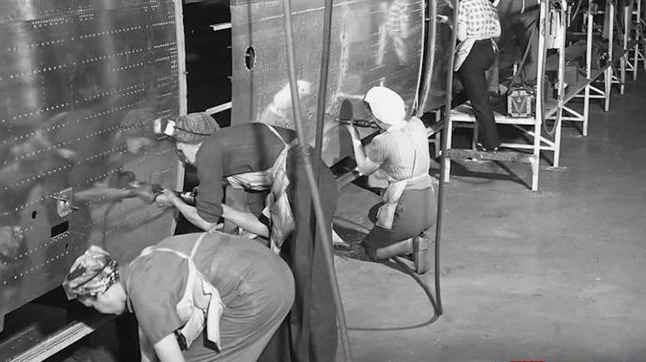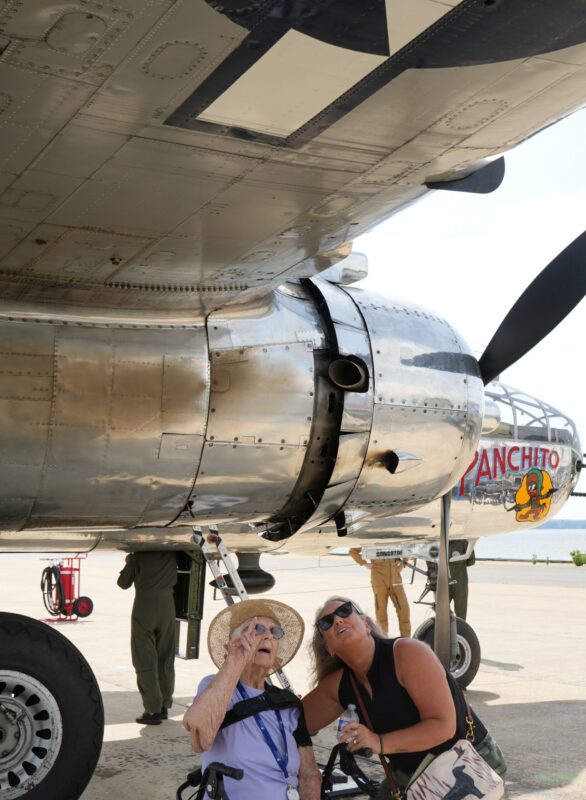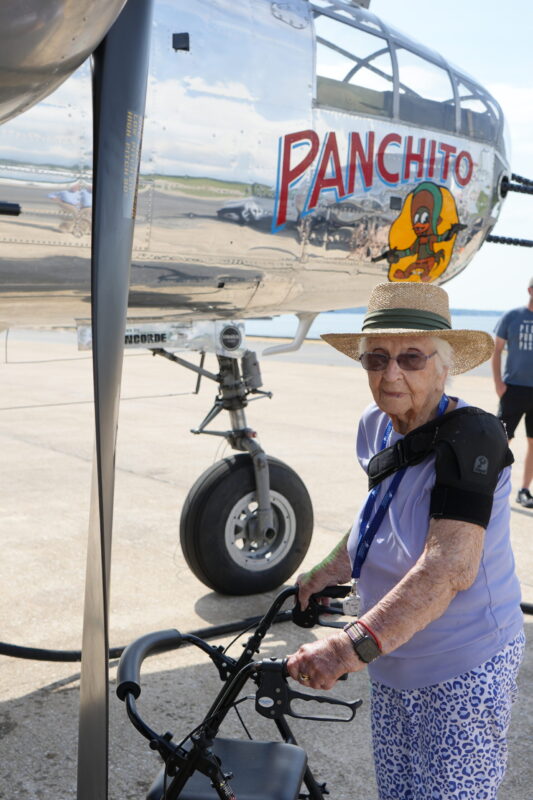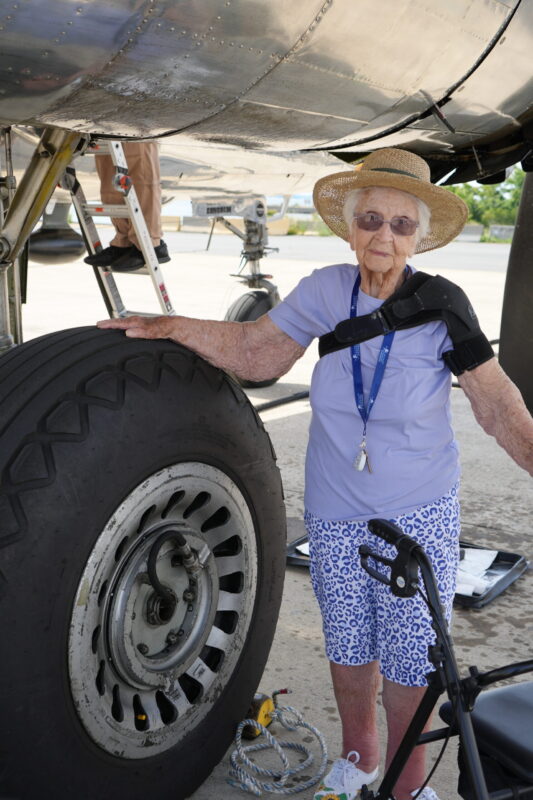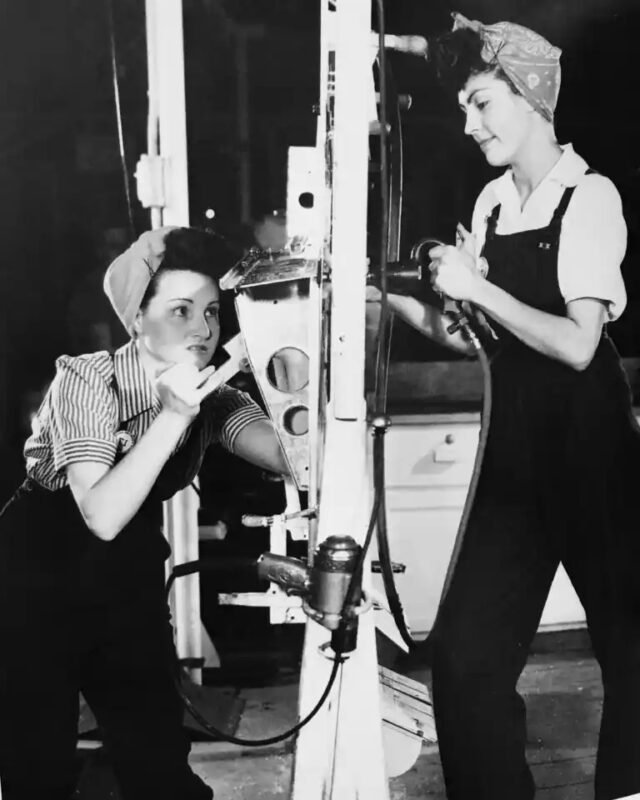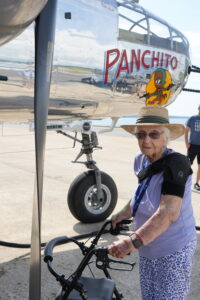 NAVAL AIR WARFARE CENTER AIRCRAFT DIVISION, Patuxent River, MD. – Betty Jean Holly will celebrate her 99th birthday this weekend – just two days after the 80th anniversary of the allied landings on D-Day.
NAVAL AIR WARFARE CENTER AIRCRAFT DIVISION, Patuxent River, MD. – Betty Jean Holly will celebrate her 99th birthday this weekend – just two days after the 80th anniversary of the allied landings on D-Day.
During a recent visit to the U.S. Naval Test Pilot School (USNTPS), she fondly recalled working in a Kansas City factory in 1943 as a riveter building B-25 Mitchell Bombers. The B-25 was a medium bomber aircraft manufactured by North American Aviation that was used by the U.S. in every theater of World War II.
“I graduated from school when I was 17 but couldn’t work at the factory until I turned 18,” said Holly, “But as soon as I turned 18, I moved away from home and started working.”
Holly shared her story while visiting Naval Air Station (NAS) Patuxent River, Maryland, where she had an opportunity to see a B-25 up close at the schoolhouse.
“You did a great job on those rivets as they’ve held up for more than 80 years,” said Larry Kelley, Executive Director of the Delaware Aviation Museum Foundation and owner of the B-25 named “Panchito.” Panchito flies in from Delaware twice each year to train USNTPS test pilots under instruction.
It was during one of those training flights last week that Southern Maryland local James Marsh saw the B-25 and thought of his wife’s grandmother. Marsh is a retired engineer who lives in California, Maryland and enjoys playing a round or two of golf on the base course.
What Marsh saw was a large, shiny, silver propellered plane with two vertical stabilizers on the rear, an all-glass nose, and glass turret on top. The two radial piston engines are part of what makes the B-25 a truly unique aircraft for USNTPS students to fly, land, and taxi on the runway.
“We’re very proud to have a small part in helping the school develop the world’s finest test pilots,” said Kelley. “They understand that learning from the past helps teach modern techniques for future flight test.”
Marsh said it was an amazing aircraft to see land at the base. “And I knew Betty had helped build them.”
Marsh contacted USNTPS and the school invited Holly and her family to come see the plane on the flight line outside the school’s hangar.
“This is absolutely incredible,” said Holly, sitting in the shade of the wing panels she may have helped build. “I never expected this opportunity and I’m so grateful.”
Holly shared how she left her rural Kansas home with a friend to move near Kansas City for the job with North American Aviation. The two girls worked 12-hour shifts, six days each week.
“My mother said I was only allowed to work there if I did the night shift,” said Holly, who laughingly said her mom thought working nights would keep her out of trouble. “She was afraid I’d go to bars.”
“We had two 30-minute breaks when we ate lunch,” Holly said. “The conveyor belt would stop and we would all just sit down on the floor and take a break.”
According to Holly, the only safety requirement was that they could not wear sweaters, as the yarn could get caught on the machinery.
Though sweaters were a safety risk, modern considerations like hearing protection were not a concern on the loud factory floor.
“I liked working there,” she said. “It was interesting work and fun.”
Holly said aside from the breaks, they stood for the entire shift facing a partner as the wing portions came through hanging from a conveyor belt.
“One of us drilled the holes and pushed the rivet in while the other held the ‘bucking bar,’” she said. A bucking bar is a hand-held anvil used to form the end of a rivet. “Every four hours we would switch positions as drilling and riveting were harder efforts.”
The factory was also historically significant from an integration perspective. An Executive Order by President Franklin D. Roosevelt in 1941 banned discrimination of workers in defense industries and government because of race, creed, or color. While working at the factory, Holly said she met the first person of color she had ever seen.
Holly remembers “war” being a major part of her youth. “I grew up with war,” she said. Almost all of the young men she knew from her small town were drafted and she felt it was part of her patriotic duty to serve in some capacity – and the factory provided her with an opportunity for independence.
“I was just happy to get away from home,” she said. And earn a paycheck. “My first paycheck was for $.49/hour.”
Though there is really no way to tell if Holly’s rivets are onboard Panchito, it is a distinct possibility. “We often scratched our initials on the inside panels,” she said.
Kelley and his crew have seen many B-25 wing parts in their role at the museum and can verify that many of the women who were riveters left their mark. “We’ve seen hearts and initials and other messages scratched into the metal,” he said. “Perhaps someday we’ll see the inside of Panchito and be able to see if Betty’s initials are there.”
USNTPS trains pilots and engineers for development test and evaluation of aircraft and aircraft systems. USNTPS is a component of Naval Test Wing Atlantic, the developmental test wing under the Naval Air Warfare Center Aircraft Division (NAWCAD) in Patuxent River, Maryland. NAWCAD advances capability and operational readiness for Naval Aviation.
Story summary – Betty Jean Holly, a real-life Rosie Riveter, poses with a World War II era B-25 bomber on the flight line at the U.S. Naval Test Pilot School in Patuxent River, Maryland on June 4, 2024. Holly, who celebrates her 99th birthday two days after the 80th anniversary of D-Day, drilled holes and installed rivets onboard the warplanes in 1943 on a factory production line. During the visit, she fondly recalled the factory job that gave her both independence and an opportunity to show her patriotism when many of the young men from her town were drafted. Test pilots under instruction at the school fly the B-25 bomber during training to learn evaluation of different flight characteristics.
